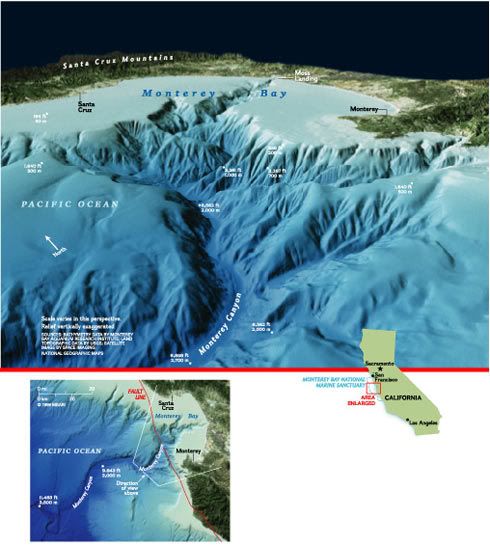Monterey Canyon off California
For many years scientists have told us that the Grand Canyon took many, many thousands of years to form. This theory is based on their belief that it took the Colorado River that long to cut into the earth. Just a little ways off the coast of California right between the cities of Santa Clara and Monterey is an undersea canyon that is a replica of the Grand Canyon in size and characteristics. This canyon, Monterey Canyon, is often referred to as the undersea Grand Canyon. Scientists are seeing it grow and change rapidly right before their eyes, not taking many thousands of years to form but relatively few years.

Grand Canyon of the Sea
Beginning as a tiny gully just a short swim from California's central coast, Monterey Canyon quickly slices through the shallow plateau of the continental shelf. About a hundred miles (175 kilometers) long and with water depths greater than two miles (3.5 kilometers), the canyon funnels the bounty and mysteries of the deep Pacific practically into the MBARI scientists' backyard. "We can leave the dock at Moss Landing at 7 a.m., and by 8:30 we're in 2,000 meters (6,562 feet) of water," says MBARI marine biologist George Matsumoto. The submarine canyon is often compared to Arizona's Grand Canyon, but the geologic forces that created it remain a subject of debate. Researchers are certain Monterey Canyon formed underwater, and therefore couldn't have been cut by a flowing river. They suspect catastrophic events such as avalanche-like flows triggered by earthquakes or floods. A major fault bisects the canyon, and MBARI marine geologist Charlie Paull has documented powerful currents—temporary and unpredictable—that move huge volumes of sand, among other things. "I've lost sensing devices that weigh 800 kilograms (1,800 pounds)," Paull says. "Some I find hundreds of meters down the canyon, mangled and partly buried. Others I never find."
This is more proof that the flood of Noahs days made many changes to the earth.



